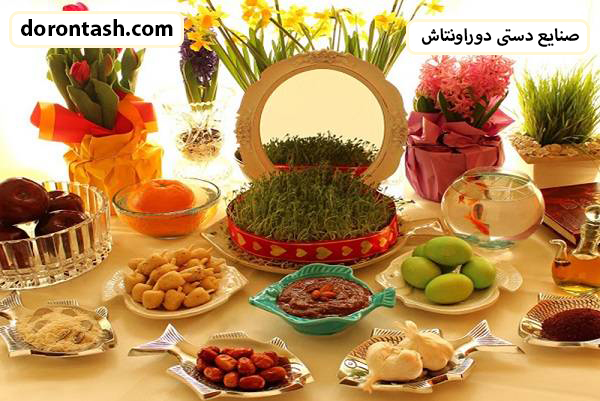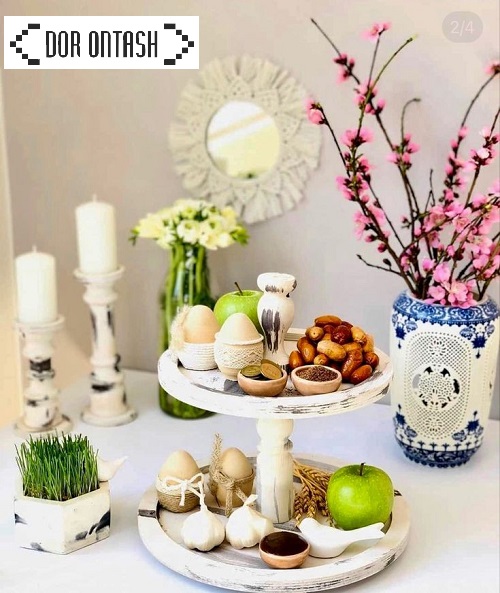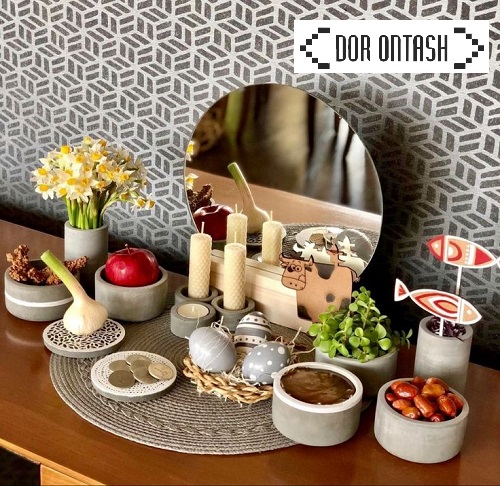Nowruz is a heritage that is celebrated every year at the beginning of the new year in different parts of the world, especially in Iran and Afghanistan. Of course, the beginning of the New Year in some other countries such as Turkey, Tajikistan, Georgia, Russia, the Republic of Azerbaijan, Kyrgyzstan, Kazakhstan, etc. is also accompanied by several days of official holidays and people celebrate the arrival of these days.
Nevertheless, in general, Nowruz Eid has an Iranian birth certificate and is considered a symbol for connecting different nations. According to the legendary narratives and according to the writings of the Avesta book, Nowruz was created during the time of Jamshid, the fourth king of Pishdadi Iran, who benefited from the power of Farah Yazidi, and when famine and drought reached all the lands, Jamshid, by the order of Ahura, auctioned off against Ahriman. it will rise.
nowruz of iran
This day in Iran and Afghanistan heralds the new year. Nowruz is an official holiday in countries such as Tajikistan, Russia, Turkmenistan, India, Pakistan, Kyrgyzstan, Syria, Iraq, Georgia, Azerbaijan, Albania, China and Uzbekistan, and people celebrate and dance.
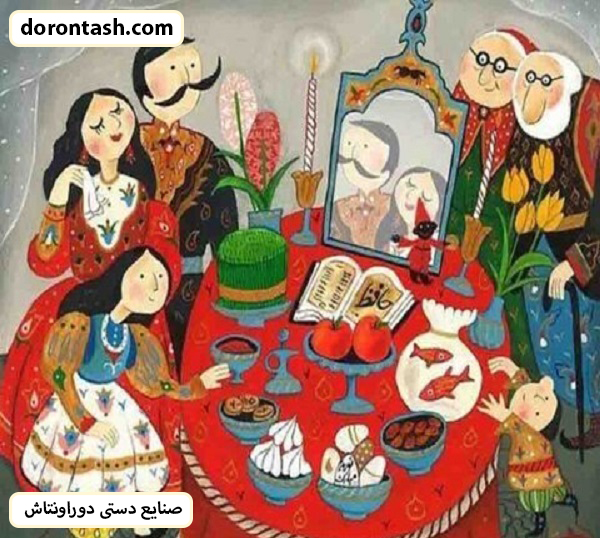
We have inherited this ancient festival from different tribes in the region. A festival with a special color and flavor, has an Iranian identity and is a symbol of the connection between Iran’s tribes and peoples. We consider Nowruz to be the beginning of the resurrection of nature, the time for the growth and birth of plants, and we believe that along with nature, we should start a new era with a new spirit and spirit and wear new Eid clothes.
The beginning of Nowruz celebration coincides with the spring equinox. The time when the sun crosses the earth’s equator in its apparent movement at the beginning of Aries, and the hours of day and night become equal. In the solar calendar, the moment of delivery of the year is counted as the first day (Hormoz Day or Ormazd Day) from the month of Farvardin.
The history of nowruz of iran Eid by examining the stories before and after Islam
In the works of Al-Baqiyyah by Abu Rihan Biruni, it is mentioned that celebration and celebration had a high place in the culture of Iran. It is interesting to know that every day had a special name in the ancient Iranian chronology, and in all months, the day that had the same name as that month was that day. They used to celebrate and be happy, so various festivals such as Abangan, Tirgan, Mardadgan, Mehrgan, etc. were held throughout the years.
Of course, apart from these celebrations, there are other ceremonies such as Yalda, Gahanbarha, Sedeh, etc., one of the most important of which is Nowruz, which now has a history of three thousand years and is one of the oldest. It is considered the oldest national holiday in the world.
Where does Nowruz belong to?
Nowruz is an old and ancient celebration of many nations that has been inherited, but it has acquired an Iranian birth certificate and is referred to as a symbol of connecting Iranian people and nations of Iran. Nowruz, with the official title “International Nowruz Day”, has been registered as a cultural and spiritual heritage of mankind by UNESCO , and this day is also considered one of the holy days and religious holidays of Zoroastrians and Bahais.
It is also written in the Shahnameh about Nowruz: Jamshid was passing through Azerbaijan when he ordered a throne to be placed for him, then he sat on that throne with a glittering crown, and with the sunlight shining on that golden crown, brightness And abundant light covers the world and people call that day Nowruz because of happiness.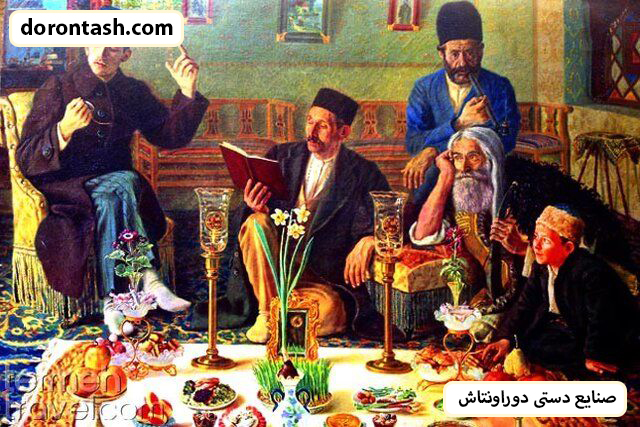
nowruz of iran literature
In Nowruz Eid, there are different terms and customs that shape Nowruz literature. In the following, we introduce these terms to you so that you can get to know more about Nowruz literature.
new Year pray
Iranian families pray for the New Year at the Haft Sin table to start the new year with a good mood. In the following, you will read the prayer for the delivery of the year and its Persian translation:
O the converter of hearts and eyes
Or the wise Alil and Nahar
O converter of the year and adverbs
About our situation, the situation is better
***
O changer of hearts and views
O strategist of day and night
O manager of years and states
Change our situation for the best
nowruz of iran and its special customs
The customs and traditions of the ancient celebration of Nowruz, in other words, Nowruz, have an Iranian color and identity, and these days are a symbol of the bond between Iran’s tribes and people. This summer celebration is an ancient promise of the regrowth of nature and the birth of plants, and people believe that with the renewal of nature, you should wear new clothes and celebrate with your loved ones. Accordingly, in the solar calendar, Nowruz, as a symbol of the victory of good over evil, has coincided with the moment of delivery of the year on the first day of April. Therefore, from the past to the present day, these days have been accompanied by special customs, among which we will mention the following.
Nowruz has been the biggest religious festival of Iranians since ancient times and is considered the symbol of spring festivals in the world. Despite the many narratives and stories that have been told about the origin of this festival, the most important reason for its origin is the beginning of spring, the resurrection of nature and the renewal of life. This celebration of nature is a combination of the ritual and religious tendencies of the ancient Iranian people and the Aryans, and over time, the belief has been formed among them that the month of Farvardin is the month of their holy festivals and their special celebration. Therefore, the roots of some of the traditions that will be mentioned go back to this thinking and respect for the Faruhars.
Fireworks Wednesday
Nowruz celebration starts with the night of the last Tuesday of the year and on this day, people celebrate Chaharshan Suri with special customs and light a fire with every family on the roof or the surrounding area of their house and jump over it and believe By jumping over the fire, all diseases will be removed from the person. Sitting on the floor, breaking spoons, breaking jars, reciting the Shahnameh, etc., are among the most important customs of the Syrian Wednesday, which are still prevalent in some regions.
On this day, people hold a ceremony that goes back centuries to ward off evil and calamity and to fulfill their wishes. The special ceremony is held on Wednesday night. They light big fires and jump over it and sing a song (your redness from me, my yellowness from you). Apparently, the ceremony of Chaharshanbe Suri is derived from the ancient rituals of Iranians, which is still prevalent among them and in other forms among the survivors of the Aryan tribes, and “sur” in Persian language and literature and some Iranian dialects means “celebration”, “party”. And “red” has arrived.
Sur celebration has been customary in Iran since ancient times. Before Islam entered Iran, each year had 12 months, and each month had 30 days, and each of these 30 days had a specific name, and after Islam entered Iran, weekly divisions were added to it. In ancient Iran, at the end of every month, it was customary to celebrate and feast under the name of Sur. Mukhtar used this opportunity to kill Yazid in the city of Kufa, where most of them were Iranians, and took revenge on Yazid during this festival, which coincided with Wednesday. After a few years passed after the arrival of Islam in Iran, the festival of Sur in Iran slowly faded and was limited to the last Wednesday of the year. Sur festival is an authentic Iranian ceremony and has no foreign origin. Fire is one of the four elements, and it is the only element that does not get contaminated, for this reason, these customs have been customary since ancient times.
pesrian kilim bags is best gift for nowruz of iran
Housecleaning
Among the other customs of Iranian people in Nowruz Eid, we can mention house shaking. So that on the eve of Nowruz Eid in Iran, the whole house and its accessories are washed and cleaned.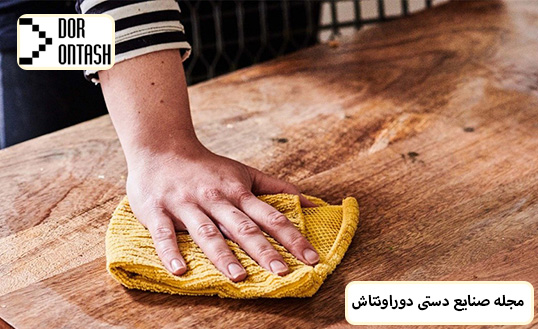
At least one month before the new year, families start a complete spring cleaning or house-shaking, which usually has to be finished before the new year begins. Furniture should be moved, surfaces should be cleaned and polished, closets should be tidied and curtains should be washed. In short, everything in the house should be cleaned and shiny and all useless things should be thrown away. With the arrival of the new year, Iranians try to renew their family relationships, put aside all the turbidity of the past year, and resolve their differences.
But what is the reason for the tradition of house moving and spring cleaning and how old is it? This culture is rooted in two old traditions that go back to ancient times, up to 3000 years before Christ. At the same time, spring swings seem to be an important part of our nature as humans.
Shaking house and the science of
spring cleaning biology has more to do with human biology. In the cold days of winter, we have less activity and motivation, and there is a good reason for this state. The behavior of us humans depends on the cycle of seasons. Due to the lack of sunlight during the boring winter days, our brain produces more melatonin. Melatonin is a chemical that causes insomnia. The level of melatonin depends on the amount and frequency of exposure to sunlight. The more time we spend outside the home environment, the less sleep hormone or melatonin we produce. Some believe that the rocking house means awakening the soul from the sleep caused by melatonin.
Haft Sin
A few hours before the delivery of the new year, Iranian families spread the Haft Sin table and by placing the Haft Sin including apples, vinegar, elderberry, semno, sabze, sumac and garlic as well as Quran, fish, mirror, hyacinth and… this day They congratulate each other. Each of these symbols on the Haft Sin table has its own meaning.
Haftsin is a table that Iranians decorate during Nowruz. This tablecloth can be placed on the floor or on the table. Family members usually spend the moment of handing over the year next to the Haftsin table. Some keep the table during the thirteen days of Nowruz and at the end of this period, on the thirteenth day of Nowruz, they give the greens to water.
The Haftsin table is not exclusive to Nowruz and some prepare this or similar table for marriage ceremonies or Shabbat Chele.
According to the Iranica encyclopedia, other nations that have common culture and traditions with Iranians (such as Afghans, Tajiks, and Armenians) do not present this table, and this table is not even between Kurds and Zoroastrians (both of whom are usually custodians of ancient Iranian traditions). It has not been common, although recently the Haftsin table has become common among urban Zoroastrians.
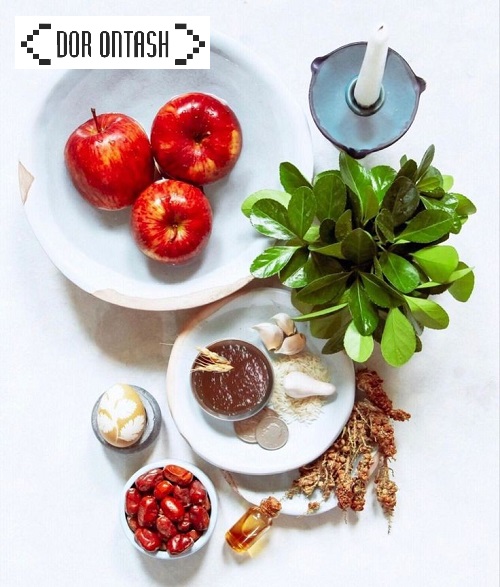 Components of the Haft Sin table and their symbols:
Components of the Haft Sin table and their symbols:
garlic (a sign of health)
coin (sign of blessing and abundance)
Sumac (symbol of the taste of life)
Sanjad (symbol of love)
Apple (a sign of beauty and affection)
green (a sign of aging and renewal)
Semnu (a sign of abundance and goodness and blessing)
Vinegar (a sign of patience and happiness)
hyacinth (sign of spring)
mirror (illumination sign)
Hafez and Quran (sign of faith and belief)
Candle (sign of enlightenment)
fish (sign of life)
egg (sign of fertility)
Reward
During Nowruz, elders usually give smaller people a sum of money or a gift as “Eid” or “Nowruz”. Of course, in the ancient history of Iran, sometimes the younger ones also gave Eid to the older ones.
Giving Eid is one of the common customs among many people of the world and one of the ancient rituals of our Iranian culture.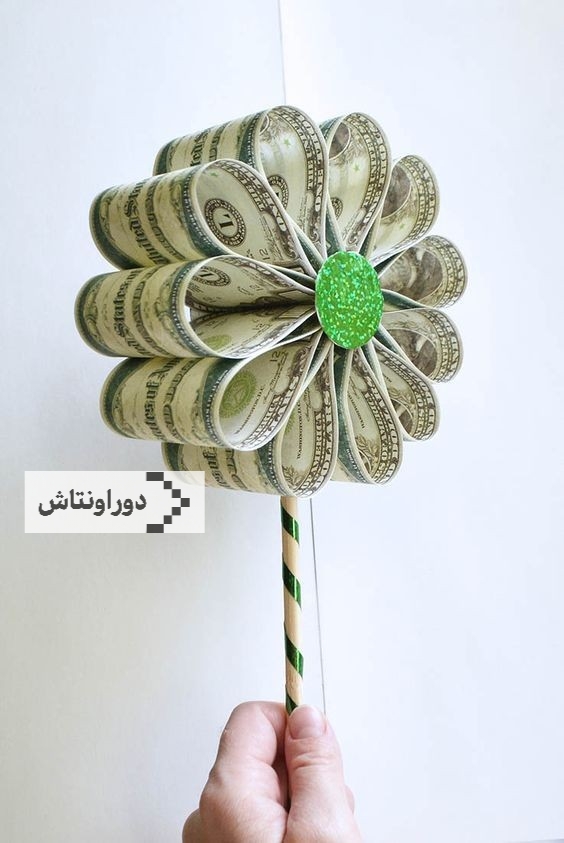
Eid giving, quoted by Abu Rihan Biruni
About the tradition of giving gifts on Nowruz, he quoted Azarbad (Mobad Baghdad) as follows: “Cane sugar was found in Iran on Nowruz, before that no one knew it. One day, Jamshid saw a reed with a little oozing out of it, because it was a sweet sight, he ordered to take out this reed and make sugar from it. And people gave each other sugar by way of congratulation, and they repeated it in Mehrgan, and it became a custom to give gifts.
Among Iranians, giving Eid is not only limited to family members. Giving an Eid to the janitor, sweeper, letter carrier, etc. (the low-income and hard-working class of the society) has blessings, omens and “hands of pride”.
For some people, it was important to see the omen of Eid and make a plain from the hand of the Eid giver, which seems to have faded somewhat in recent years.
However, Nowruz, as a cultural phenomenon in our country, has features that distinguish it from other occasions.
Be happy
People greet each other with the arrival of the new year. “Happy New Year” is the famous celebration of Iranians at the present time; But in the past, the sentences they used to say to each other for happiness were much more complex and full of content than today. Historians consider one of the common expressions of that time to be “one hundred years to these years”. In recent decades, with the popularity of recitation and recitation in the country, terms such as “Nowruz Pirouz” or “May your New Year be blessed and blessed” are used more than before.
 Thirteen Badr
Thirteen Badr
On the 13th of Farvardin, Iranian people leave their homes and go to the lap of nature to remove impurities. There are different opinions about the philosophy of Thirteen Badr. Some people attribute it to the opening of Nahsi Thirteen. Some also argue that since the word “door” means “door and plain”, they consider 13 Badr as the day of taking refuge in door and plain. The famous tradition of 13 Badr is “tying greens”. The philosophy of this work is to connect life with nature, and people wish for freshness and vitality with this work.
Thirteen Badr is a celebration!
The image that we have from day 13 is more of a picnic and a nature trip, which is not far from reality. But it was not like this from the beginning.
Nowruz is one of the ancient rituals of Iranians, and for this reason, Sizdeh Bedarem was always in Iranian culture as one of the celebrations of this Eid from the very beginning.
On the 13th of Badr, which is usually the last day of the Nowruz holiday, people go to the lap of nature to welcome the new year at the foot of the mountains and plains, and also renew their bond with nature (it is clear that many people spend a lot of time or energy on They do not have nature tourism).
The root of Thirteen to the Door and Thirteen to the Old Door
Every city and country you go to has a name for this day: the people of Kerman call this ceremony Sizdeh Gardi , in Damavand they call it Size Beh Dar , the people of Khansar and Komle say Sinzdeh Beh Dar , in Gonabad they know it as Bibi Gardi And in Abyaneh it is called Sazaid . But by whatever name you call it, 13th is the day when people go to the lap of nature to get rid of sadness and celebrate.
Tracing the roots of ceremonies and traditions is a difficult task, but researchers have always tried to discover the philosophy and why of their origin. For example, Mehrdad Bahar, an Iranian researcher and mythologist, returns the 13-door to its mythical place of birth and considers it a symbol of pre-creation chaos. Bahar says that every chaos has been a nuisance before getting order. In addition, in Iranian mythology, the age of the universe is 12 thousand years and it is taken from the twelve signs. After these twelve thousand years, the world period will close. Humans, who had to fight with the devil and his forces for all these 12 thousand years, are finally approaching victory. With the appearance of the savior Sushyant, the rest of the demonic forces are also destroyed. The twelve days of Nowruz can be a symbol of these 12 thousand years and the 13th day can also be the beginning of the 13th millennium and liberation from the material world and return to the world of mino.
In another interpretation, it is said that the 13th day of every month belonged to the god Tir or Tishtar, who was also the god of rain, and the 13th day of the new year was the day of asking for rain for new crops. On this day, the god of rain fought with the land demon, and if he won, it would be a rainy year. On this day, people went to the nature, sacrificed to the rain angel and waited for his victory over the drought demon. It is said that this day was not in Nahs mythology and ritual ceremonies were held on it.
Whatever the origin of the ceremony, it seems that at first it was not considered as a day of mourning and gradually it has become a day of mourning that should be celebrated. During the Qajar period, people believed that the joy of April 12 should not be mixed with the 13th, which is a day of mourning, and that it should not be allowed at home, and for this reason, they left their homes.
When did Nowruz Eid become official in Iran?
According to the narratives, the main origin of Nowruz is in ancient Iran, but according to historians, the Sumerians should be mentioned as the first human civilization to hold the first Nowruz celebration. Therefore, Nowruz has reached from Sumer to Akkad, and from there to Babylon and Assyria. It has also been transferred from the Elamites as the initiators of civilization in Iran to the Achaemenid and Sasanian periods, etc.
Cyrus the Great was the first Iranian king and the founder of the Achaemenid dynasty, who officially named Nowruz in 538 (BC) and made this day a national holiday. On this day, Cyrus has implemented special programs such as promoting the rank of soldiers, cleaning public places and houses, and pardoning convicts in prison.
The observance of this ritual has been continued during the time of other Achaemenid kings, so that the Nowruz celebration was held in Persepolis during the time of Darius I of Achaemenid, and on the occasion of Nowruz, a gold coin was minted with the image of a soldier shooting. It should be mentioned that during the Achaemenid period, Nowruz celebration was very long and from March 21 to May 19, people used to celebrate and celebrate.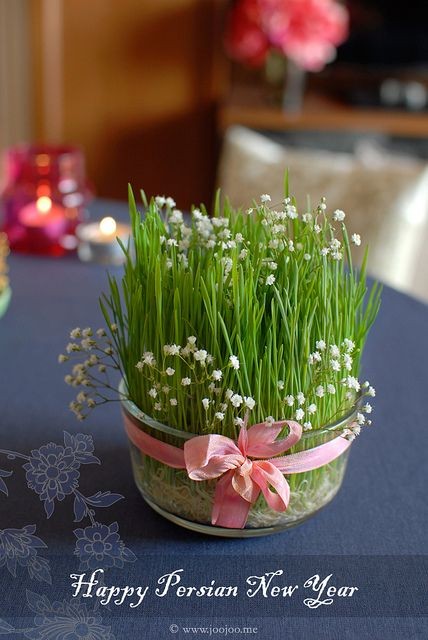
Global registration of Nowruz Eid
In general, Nowruz has Iranian roots and is more than 3 thousand years old, but this day is also celebrated in other countries. Therefore, the United Nations General Assembly registered Nowruz in its calendar on March 4, 2018, corresponding to February 23, 2010, and accordingly, March 21 was recognized as the “International Day of Nowruz” in the Gregorian calendar. Also, on the 8th of Mehr 1388, the scientific and cultural organization of the United Nations, known as UNESCO, registered Nowruz as a world heritage.
Text and photo of ancient Nowruz greetings 1402
May the wind of Nowruz be an idol in Bostan
To make every tree become another toy
In this delightful spring; Mezare Sine Ethan from Sabzeh Mohabbate; Green and windy
Remembering every day is better than the feast of Cain, the source of the world’s happiness
In this green and spirit-giving spring, there is hope:
The opinion of the Lord’s seal in your heart on durability
Rest in peace
Your work on the system
Your government is over
May your day and nowruz be blessed.
I present my warmest and warmest congratulations to you.
May your heart be happy in the eyes of the right, and your life be blessed with eternal love.
Nowruz alone
There is no excuse for congratulations.
Rather, it is an opportunity
To fulfill our ancient traditions.
I hope the moments of your life
Be full of joy and peace.
Nowruz is a lasting memory
yesterday’s friends of this land and pasdash
Purities, virtues and bravery
On all Iranians
Blessed be Nikosurasht.
Spring has come and fortune will increase
May a thousand flowers be conquered from all sides
Golshan should be the seat of Sultan Nobahar
Because the throne of the king will be built
happy New Year
Eid came and Eid came
The help that Remid came
Eid was abundant
May the wind be like this
happy New Year
Nowruz comes from the mild breaths of spring
And on the flowery table, Haft Sin is blown;
A table where goldfish,
A new repetition of life
There is a small strait of water.
Neither jacket nor hat
No striped gloves
With a comfortable dress
In the grass and nature
Ball game and swing game
Beside the fountain
spring come spring
to to! What kind of bag is it?
Eyes open brightly
And the hearts are close to each other and the hearts find peace again
At the beginning of the new year, I am encouraged by the future of kindness and purity.
The feeling of spring, like a lotus, wraps around the body of nature
And winter moves.
thankfully crossing the winter passes,
thanks to resistance and standing,
Thanks to the new opportunity that they have given us,
We open “Seven Scenes”.
Thanks to love, which was our only warm oven,
The only furnace of our cold hearts,
We open Haft Sin.
happy Norooz

